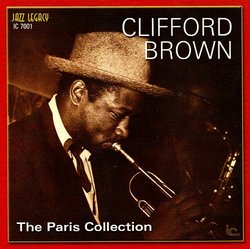| All Artists: Clifford Brown Title: The Paris Collection, Volume 1 Members Wishing: 3 Total Copies: 0 Label: Inner City Records Release Date: 5/12/2009 Genres: Jazz, Pop Style: Bebop Number of Discs: 1 SwapaCD Credits: 1 UPC: 077712770019 |
Search - Clifford Brown :: The Paris Collection, Volume 1
 | Clifford Brown The Paris Collection, Volume 1 Genres: Jazz, Pop
"It was September, 1953. Lionel Hampton's band was in the midst of an extended European tour. Response was enthusiastic, especially for the younger and virtually unknown players like Art Farmer, Gigi Gryce, Quincy Jones an... more » |
Larger Image |
CD Details
Synopsis
Album Description
"It was September, 1953. Lionel Hampton's band was in the midst of an extended European tour. Response was enthusiastic, especially for the younger and virtually unknown players like Art Farmer, Gigi Gryce, Quincy Jones and Alan Dawson. It was Clifford Brown, though, that set off the fireworks. Hampton, for reasons that are still unclear, imposed a ban against extracurricular recording by his musicians. Fortunately, the combination of intrepid European producers and players wanting to be heard led to several "underground" sessions. The tracks included here document the most significant of these, the Paris dates of 1953.
Brownie was only 22 years old. His star, however, had been ascending quickly. He had won the respect of Fats Navarro, his idol. He also had a solid endorsement from Dizzy Gillespie. In 1949, after Brownie had sat in with Diz in Wilmington, Delaware, Gillespie told Max Roach: "Man, there's a cat down there in Wilmington who plays piano and blows the shit out of the trumpet." The Paris sessions were organized by pianist Henri Renaud, who successfully combined Hamp's top players with his own colleagues. The dates fell into two formats, big band and small group. Gryce's "Brown Skins" is a two-part opus in the Ellington tradition. In the first section, Brownie's heroic voice etches a stately theme stretched over lush winds and muted brass. After a stinging climax, Clifford leads the band into a bright medium groove and sails with boppish abandon. Like all great improvisers, Brownie was never content to repeat himself. In take 2 of "Brown Skins," he sharpens his bite and fashions !
a more aggressive essay than that of take 1. Similar contrasts are found in the other titles with a second take. In both big band and combo settings, the Paris dates capture the passion and precision that made Brownie so unique. After his return to the States, these qualities were brought to intense focus in the historic group he co-led with Max Roach. That, however, came to a tragic end when he was claimed by an automobile accident on June 26, 1956. Though Brownie's star burned but briefly, the legacy he left us is rich. An important part of that legacy, the Paris Collection, is contained herein."
Brownie was only 22 years old. His star, however, had been ascending quickly. He had won the respect of Fats Navarro, his idol. He also had a solid endorsement from Dizzy Gillespie. In 1949, after Brownie had sat in with Diz in Wilmington, Delaware, Gillespie told Max Roach: "Man, there's a cat down there in Wilmington who plays piano and blows the shit out of the trumpet." The Paris sessions were organized by pianist Henri Renaud, who successfully combined Hamp's top players with his own colleagues. The dates fell into two formats, big band and small group. Gryce's "Brown Skins" is a two-part opus in the Ellington tradition. In the first section, Brownie's heroic voice etches a stately theme stretched over lush winds and muted brass. After a stinging climax, Clifford leads the band into a bright medium groove and sails with boppish abandon. Like all great improvisers, Brownie was never content to repeat himself. In take 2 of "Brown Skins," he sharpens his bite and fashions !
a more aggressive essay than that of take 1. Similar contrasts are found in the other titles with a second take. In both big band and combo settings, the Paris dates capture the passion and precision that made Brownie so unique. After his return to the States, these qualities were brought to intense focus in the historic group he co-led with Max Roach. That, however, came to a tragic end when he was claimed by an automobile accident on June 26, 1956. Though Brownie's star burned but briefly, the legacy he left us is rich. An important part of that legacy, the Paris Collection, is contained herein."

 Track Listings (11) - Disc #1
Track Listings (11) - Disc #1